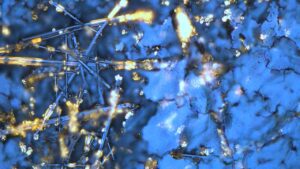Posted on January 17, 2024 in ASRC News, Nanoscience Initiative

Traditional scientific methods for exploring the complexities of life break things down into smaller pieces and study how each part affects the big picture. Living systems are made up of billions of tiny interacting proteins, and scientists have made progress toward understanding the big picture by slowly putting together the pieces of the puzzle to comprehend each component. However, this process is reductionist, and according to Rein Ulijn, there’s unexplored potential in flipping this approach: assembling fundamental building blocks to forge a designed complex system from the ground up. To this end, Ulijn’s team aims to use mixtures of drastically simplified versions of proteins and observe how they exchange components and assemble to create properties like learning and memory.
Ulijn, director of the Nanoscience Initiative at the Advanced Science Research Center at the CUNY Graduate Center and Einstein professor of chemistry at Hunter College, was recently awarded $675,000 from the Alfred P. Sloan Foundation to use this new approach to study whether synthetic biomolecular systems can be engineered to learn and acquire new traits or upgrade their performance in changing environments. To avoid getting lost in the complexity, Ulijn’s team will dramatically streamline the entire system by constructing simpler puzzles with much more basic versions of life’s molecules as the pieces. Their systems will be built from peptides, which are simplified versions of proteins that have specific interaction tendencies that lead to spontaneous self-organization.
“Instead of studying one peptide at a time, we will mix and dynamically exchange them to form communities of interacting peptides,” Ulijn said. “By using a catalyst, we can enable peptides to exchange parts, like swapping words in a sentence. This allows the mixture to adapt and be amplified in response to changing conditions, which mimics learning. By also taking advantage of the aggregation of amplified peptides, sequence information can be stored and potentially retrieved later, which mimics memory.”
The research project features three goals: creating a toolbox for designing peptides that, based on their specific interaction abilities, function as building blocks for adaptive biological systems; conducting experiments to demonstrate that systems can be trained and conditioned to selectively identify specific target compounds; and providing evidence that the system will be able to retain and recover information over time, reflecting a primitive form of learning and memory. To demonstrate memory, the researchers hope to be able to create designed peptide systems that distinguish between different flavor or fragrance molecules and show a stronger response when the same molecule is introduced a second or third time.
“I am excited to be part of this newly funded initiative that explores the memory capabilities of peptides towards specific compounds,” said Kübra Kaygisiz, a newly recruited postdoctoral researcher in Ulijn’s lab. “This work will significantly enhance our understanding of the chemistry of life, and I look forward to advancing our knowledge in this fascinating field.”
The project aims to improve understanding of how complex adaptive systems acquire new functions, and new findings could pave the way for innovations in information processing and memory in both biological and artificial systems.
“Our approach allows us to study both the dynamically changing pieces and the system comprehensively,” Ulijn said. “We hope to achieve a deep understanding that empowers us to duplicate basic life-system features such as molecular adaptation, learning, and even memory in non-living systems.”
